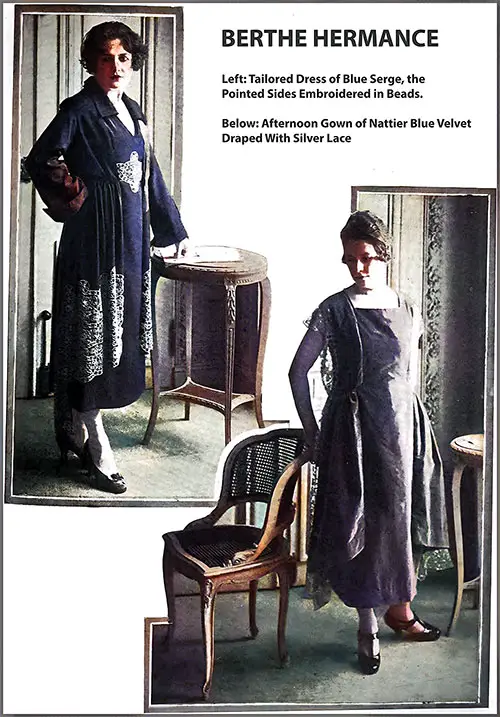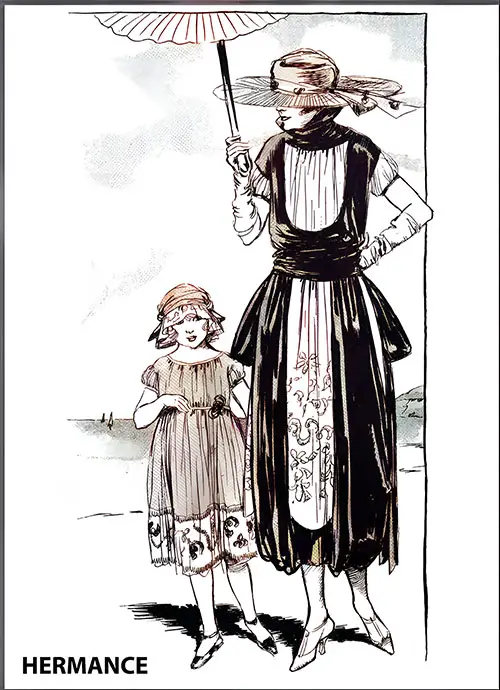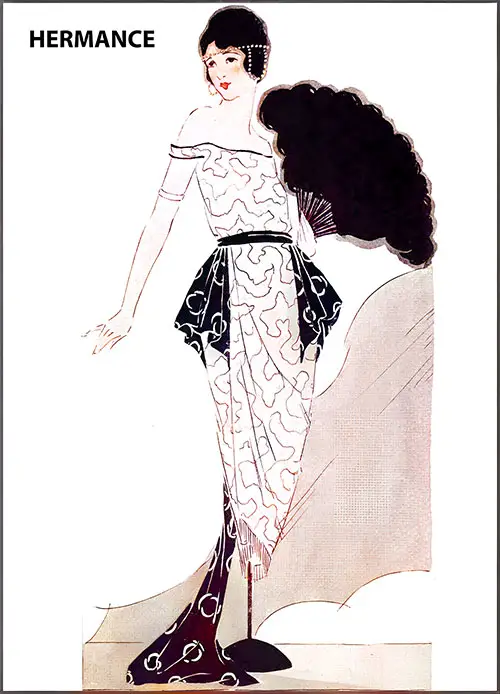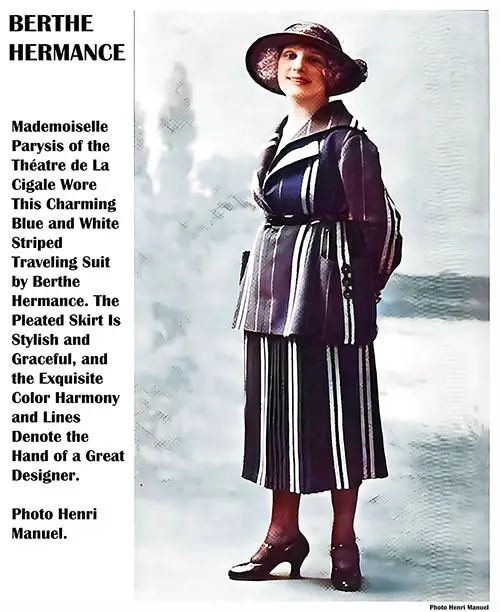Paris to the Promenade Deck: The Fashion Legacy of Berthe Hermance, 1919–1921
📌 Explore the refined designs of Parisian couturière Berthe Hermance from 1919–1921, including travel-ready suits, afternoon gowns, and stagewear worn by French actresses. A treasure for genealogists, fashion historians, and ocean travel enthusiasts.

Tailored Dress and Afternoon Gown by Berthe Hermance. (L) Tailored Dress of Blue Serge, the Pointed Sides Embroidered in Beads. (R) Afternoon Gown of Nattier Blue Velvet Draped With Silver Lace. (Garment Manufacturers' Index, September 1920) | GGA Image ID # 1a4868f13a
👗💼 Elegance in Motion: The Legacy of Berthe Hermance in Ocean Travel & Early 20th-Century Fashion
The name Berthe Hermance may not appear in modern fashion glossaries, but to the early 20th-century traveler, socialite, or theater star, it represented refined Parisian elegance tailored for mobility and distinction. This richly illustrated profile—sourced from the Garment Manufacturers’ Index and various French fashion publications—offers an extraordinary view into post-WWI couture and the golden age of transatlantic ocean travel, when what you wore onboard mattered just as much as where you were going.
This feature is a must-read for teachers, students, genealogists, fashion historians, and those researching transatlantic social life in the 1919–1921 period, offering rare insight into couture trends that bridged Parisian ateliers and the grand ocean liners of the era.
The World of Berthe Hermance
Step into the exclusive world of Berthe Hermance, where enchanting Afternoon Gowns, meticulously designed for the discerning Woman, and a captivating line of lavishly braided tailleurs are masterfully showcased. Each piece is a testament to our unwavering commitment to quality and attention to detail, ensuring you feel truly privileged to be part of this unique experience.
For the past three years, Berthe Hermance and her two esteemed partners, all of whom are respected members of the ex-firm of Bechoff-David, have graced the Champs-Elysées. Their patience and impeccable taste have now borne fruit as they cater to a discerning Parisian clientele, a testament to their unparalleled expertise and reputation in the industry. You can be confident in your choice with Berthe Hermance.
Berthe Hermance's collection is a testament to her unique vision. The tailor-made pieces, crafted with blue and nègre velvets and duvetyns, embody classical winter shapes, ensuring you feel elegantly timeless. The designs are elevated with intricate braiding, creating a distinctive look that will make you stand out.
Frequently, big pockets are bordered by fur or embroidered in appliqué. A powder blue duvetyn pinched at the waist has a braided collar, cuffs, pockets, and sides.
Plaids are prettily treated here. Grey and black plaid is seasonable; a plaid skirt is worn with a medium-length blue jacket; over the latter is a cape much longer at the back and lined with the plaid. A long, tight négre velours suit opens to show a very large and magnificent gold waistcoat.

The Fashion Scene Has Seen a Consistent Influence From the Directoire Style, and Maison “Orange” Has Taken Notice, Embracing It as Something Uniquely Charming and Suitable for the Petite Parisienne. the Dress Features a Green Crêpe Georgette With Net Insertion Trim That Is Beautifully Embroidered. A Navy Taffeta Layer Complements an Organdy Underdress Delightfully. The Organdy Skirt Is Embroidered, With Detached Panels Elegantly Secured at the Top. if Bertha Hermance Dares to Wear the High Collar in Midsummer, We Can Be Sure She Will Remain Devoted to It in the Coming Season. (The Delineator, August 1921) | GGA Image ID # 1ca07537b8
The grand specialty in this house is afternoon gowns, which figure most extensively. They are all varieties of blue, ranging from powder to nattier, royal, and turquoise.
Persian is represented in serge, taffeta, satin, and velvet in flag and navy. Hermance's dresses are designed for gentlewomen and, as such, achieve an appearance of quiet elegance and distinction.
Among the straight serge gowns, a good navy blue model has a crossed bodice, the ends tied loosely in a loop in front. Small brick silk checks are embroidered over the hips and sides.
Another new blue serge with the red selvage has a large square of the red-bordered serge as an apron in front, the sides hanging loosely and forming a drapery.

The Leading French Dressmakers Are Placing Greater Emphasis on This Clothing Line Than Ever. This Stunning Royal Blue Velvet Dress by Berthe Hermance Features Minimal Embellishment, With Only a Small Amount of Lace at the Collar Crossing. The Fullness of the Design Is Managed So Skillfully That the Silhouette Appears Remarkably Graceful. (La France, October 1920) | GGA Image ID # 1ca0b400c8
Much black satin is combined with beige or black lace loops and wings. Among the plentiful embroidery, we find brocade designs in gray and brown braid and large round motifs made of rows of black and white silk fringe.
Silver is as plentiful as lace and embroidery. A négre charmeuse has an apron of heavy silver lace darned over and over. Another black velvet sheath has massive taffeta points at the sides, wide enough to meet and overlap, both back and front.

The Gown Depicted Above Is Made of Blue Satin Crêpe and Embroidered in Brick Red. Designed by Berthe Hermance, This New Afternoon Dress Features Rich Embroidery That Significantly Affects Its Appeal. Notably, the Girdle and Bodice Are Cleverly Combined, and What Appears to Be a Fichu Serves as a Sash, Elegantly Positioned at the Front Instead of the Back. (La France, October 1920) | GGA Image ID # 1ca0d31a5a
Evening dresses are either taffeta brocaded in silver and rather ample and puffy or closely draped across the front, tending upwards to the back like satins and panne.
An exquisite royal blue velvet follows this line. At the same time, a cherry charmeuse, the bodice crossed in the back, has a jet belt, which does not prevent the draped skirt from ending in a long loop at the left in front.

Mademoiselle Valpreux, From the Comédie-Française, Is Wearing an Evening Dress Designed by Berthe Hermance. Photo by Félix. (Les Modes, November 1919) | GGA Image ID # 1ce034d66d

Mademoiselle Parysis of the Théatre de La Cigale Wore This Charming Blue and White Striped Traveling Suit by Berthe Hermance. The Pleated Skirt Is Stylish and Graceful, and the Exquisite Color Harmony and Lines Denote the Hand of a Great Designer. Photo by Henri Manuel. (La France, June 1920) | GGA Image ID # 224b702741

With Rich Jade Velvet, Crystal Beads, and a Rose or Two, Berthe Hermance Has Created an Evening Gown for Mile. Jeanne Marmac of the Comedie Française Is Lovely at It Is Original. A Square Crystal Motif at the Waist and the Hem of the Skirt Act as a Brilliant Relief for the Green of the Gown. Photo Henri Manuel. (La France, January 1921) | GGA Image ID # 224b4e2779
"Berthe Hermance" in the Garment Manufacturers' Index, New York: The Allen-Nugent Co. Publishers, Vol. II, No. 2, September 1920: 26-27.
🌊 Ocean Travel Relevance: Fashion for the Floating Elite
Berthe Hermance’s tailored suits, traveling costumes, and afternoon gowns were not just about fashion—they were designed for movement, elegance, and presentation during public travel, particularly aboard steamships.
The “Traveling Suit” worn by Mademoiselle Parysis of the Théâtre de La Cigale (GGA Image ID # 224b702741) exemplifies this connection. The pleated skirt and harmonized stripes made it ideal for deck promenades, shipboard dinners, or arriving at foreign ports in style.
Likewise, “Going-Away Costumes” such as those described and pictured (blue serge suits with embroidered panels and velvet accents) speak to the needs of brides and actresses embarking on honeymoons or European tours by sea.
The use of durable but luxurious materials—like blue serge, duvetyn, and négre velvet—suggests that Hermance’s clients were expected to maintain elegance in motion and mixed climates, ideal for the ocean travel experience.
🧵 Highlights of Content: Most Engaging & Educational Elements
🧵 Afternoon Gowns in “All Varieties of Blue”
These gowns, ranging from powder to royal and nattier blue, were practical yet elegant staples of a well-dressed woman’s wardrobe. Their quiet opulence made them perfect for ocean liner salons or receiving guests abroad. The heavy use of braiding, silver lace, and contrasting embroidery offers valuable detail for fashion students recreating or studying historical dress.
🎭 Celebrity Endorsements: Stage Meets Style
The inclusion of Mademoiselle Valpreux (Comédie-Française) and Mlle. Jeanne Marmac (La Comédie Française) wearing Hermance gowns (GGA Image IDs #1ce034d66d & #224b4e2779) reveals her fashion house’s intimate ties to elite theatrical circles. These references are priceless for researchers documenting intersections of fashion and the arts in post-WWI France.
✂️ Couture Construction Notes
The descriptions of specific silhouettes—such as draped skirts, gold waistcoats, and embroidered fichus serving as sashes—are more than aesthetic. They provide practical understanding of fashion structure and function, ideal for students in design and history programs.
🖼️ Noteworthy Images
These images are historical treasures for those exploring early fashion:
“Tailored Dress and Afternoon Gown by Berthe Hermance” – (GGA ID #1a4868f13a)
A perfect juxtaposition of formal daywear vs. casual luxury—the bead-embroidered pointed serge dress and silver-laced velvet gown are exemplary of dual-purpose travel attire.
“Striking Frock of Royal Blue Velvet” – (GGA ID #1ca0b400c8)
Captures the trend of understated elegance. The minimal lace speaks volumes through expert tailoring and rich fabric—a timeless lesson in silhouette over embellishment.
“Gown of Blue Satin Crêpe, Embroidered in Brick Red” – (GGA ID #1ca0d31a5a)
An inventive use of color, structure, and a faux-fichu sash placement—excellent for discussions of color blocking and period embellishment.
“Japanese Dressing Jacket of Flowered Crêpe” – Though not part of this article, similar references highlight how international influences—including Japanese fabrics and French tailoring—emerged via maritime exchange.
📘 Brief Dictionary of Terms for the Casual Reader
Charmeuse: A lightweight, satin-weave fabric with a glossy front and dull back.
Duvetyn: A soft, wool-like fabric with a short nap; matte in finish.
Fichu: A small triangular shawl or scarf worn around the neck or shoulders.
Nattier Blue: A soft blue shade named after 18th-century painter Jean-Marc Nattier.
Serge: A strong, durable twill fabric often used in suiting.
Tailleurs: Tailored suits or ensembles, especially women’s formal daywear.
Velours: A plush fabric similar to velvet, often made from cotton or synthetic fibers.
🎓 Educational Encouragement for Students and Researchers
🧑🏫 Teachers and students: This article is a perfect case study for courses in fashion history, women’s studies, performing arts, or social history of travel. The inclusion of specific garment descriptions and celebrity clientele offers rich material for essays, design recreations, and cultural analyses.
💬 As the GG Archives is not a blog, students are encouraged to cite this primary source material in their work and explore related articles on transatlantic travel, Edwardian and postwar fashion, and women's economic independence through couture.
